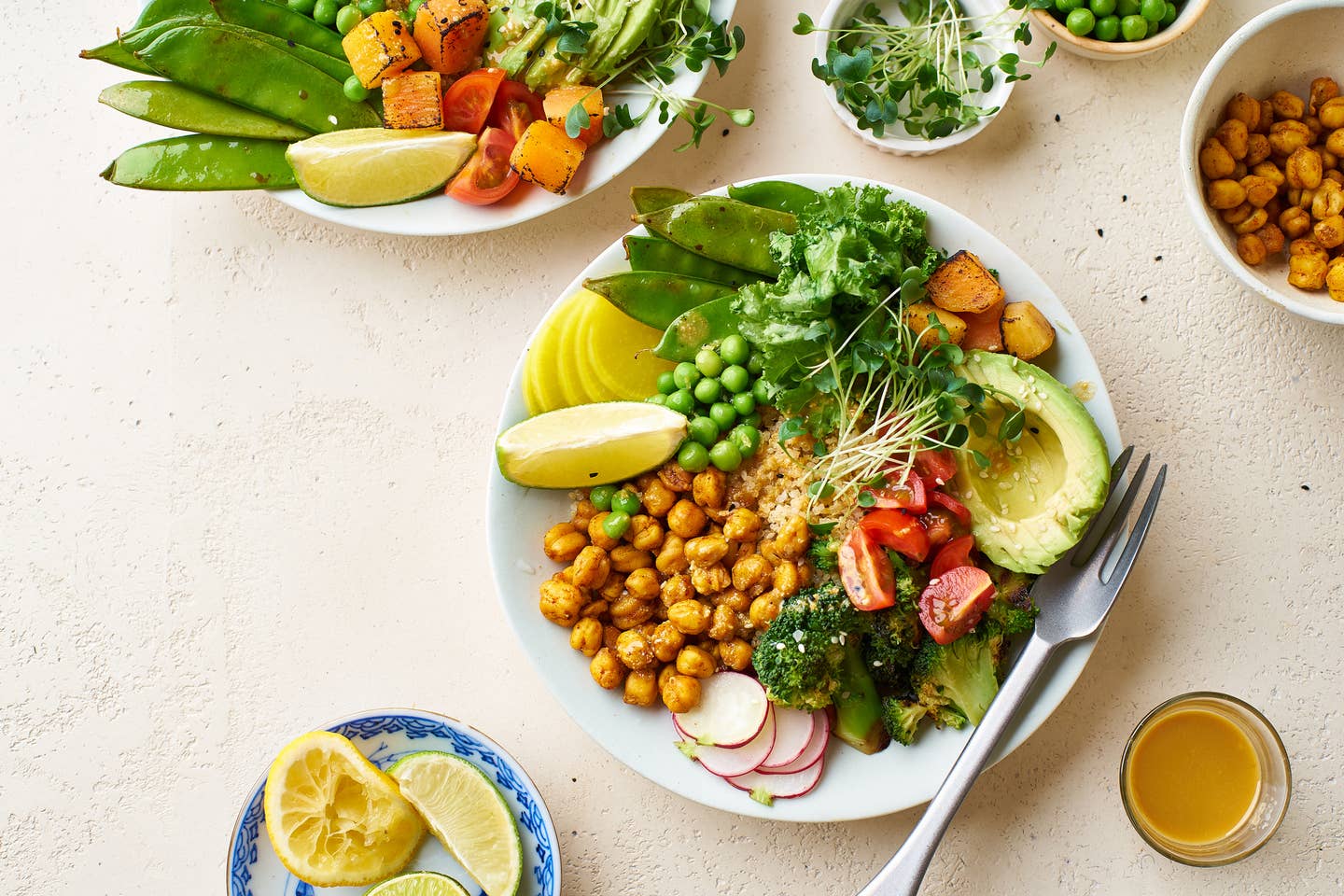
6 Mistakes Nutritionists Say You’re Probably Making When Going Plant-Based
Like anything in life, things worth having take effort. The good news: Going vegan—between exploring new cuisines and reaping health benefits like enhanced energy and weight loss—can be a ball. On the flip side, however, many nutritionists see their clients make the same mistakes again and again when starting the lifestyle overhaul. Whether it's loading up on too many processed foods or missing out on vital nutrients, it’s important to steer clear of some common plant-based flubs. Below, top nutritionists chime in on the most frequently seen mistakes, and how to correct them. Consider this your roadmap for going plant-based while covering all your bases.
1. Thinking you can get enough B12 from fortified foods or ingredients like spirulina.
Let’s debunk this myth: You simply can’t get enough B12 from a vegan diet alone. “Anyone on a plant-based diet plus anyone over the age of 50—regardless of diet—needs to supplement with vitamin B12 to avoid potentially irreversible neurological damage,” says Julieanna Hever, MS RD CPT, Plant-Based Dietitian and author of The Healthspan Solution and Plant-Based Nutrition (Idiot's Guides). “We recommend supplementing with cyanocobalamin [a manufactured form of B12] in one of the following three-dose regimens: 50 micrograms (mcg) twice daily, 150 mcg once daily, or 2500 mcg once weekly.”
Amanda A. Kostro Miller, RD, LDN, who serves on the advisory board for Fitter Living echoes this sentiment: “Not getting enough B12 can lead to pernicious anemia and associated symptoms such as fatigue, paleness, weakness, weight loss and irritability.” Your nervous system and red blood cells will thank you for taking a supplement. Consult with your doctor or nutritionist to review your personal needs.
2. Not drinking enough fluids.
When you go plant-based, the fiber you consume is going to skyrocket (yay for fruits, veggies, legumes, and whole grains). That’s a good thing, but you need to plan accordingly to keep digestion running smoothly. “Fiber helps move things along in your digestive tract so that you can easily ‘go,’” shares Kostro Miller. “While it’s great to have regular bowel movements from more fiber, make sure you also increase your water intake, otherwise all that fiber can constipate you.”
3. Not getting enough protein.
It may be a little cliche, but nutritionists regularly see this with the vegan and vegetarian set, especially those just starting out who may not know how to compensate for getting enough protein sans meat. “I see this often with plant-based eaters, and the result is often that you may feel hungry all day long,” cautions Amy Gorin, MS, RDN, a registered dietitian in the New York City area. “It’s important to include sources of protein with every meal. You can vary these up. For instance, you can include edamame in a vanilla smoothie and kidney beans in a vegan power bowl. You can even include powdered peanut butter in a vegan pudding or vegan cookies”
Other ideas: Nutritional yeast adds protein to pasta dishes or popcorn (not to mention, it has a delicious cheesy flavor to it), and sprinkling hemp, flax or chia seeds into salad dressings or oatmeal enhances the protein content of your meal. Currently, we’re swooning for protein-packed pea milk.
4. You aren’t vigilant against iron deficiency.
Along with B12, iron is another nutrient plant-based people should make sure they’re getting enough of, especially women. “Women of childbearing age and young adolescent females are at increased risk for iron deficiency or iron-deficiency anemia. If you are plant-based, you may not be getting enough iron since animal meat is not consumed and/or your plant-based diet is not well-rounded,” explains Kostro Miller. “Plant-based iron is not as easily absorbed [as that from animal sources], so make sure you eat it with vitamin C foods like a glass of orange juice. Vitamin C helps the uptake of iron.”
In some instances, your doctor may prescribe an iron supplement, but that can have not-so-fun side effects like dark stools so you’ll always want to chat with your doc first.
5. Skimping on fruits and veggies.
“An important part of plant-based eating is eating plants! I see too often that vegan eaters want to eat more of the comfort foods such as pasta and less produce,” notes Gorin. “Make it a point to add a fruit or vegetable to every eating occasion.”
It’s easier than it sounds. One of Gorin’s favorite tricks? Adding puréed butternut squash to soups, pasta dishes, sauces, and more. Some of our favorites? Making it a point to enjoy our Smoothies of the Day and never saying no to kale chips.
6. Assuming your new diet is automatically healthier.
“Even though plant-based diets do have vast health benefits, you have to still construct a well-rounded and healthy plant-based diet in order for it to be healthy,” says Kostro Miller. No surprises here but heavily processed vegan fast food is still fast food, and sugar-loaded vegan ice cream isn’t going to make you glow like Gwyneth.
Keep the “plant” plant-based and strive to eat as many plants in their original form and keep as few processed foods in your diet as possible, and you’re sure to feel great. Load up on cookies and french fries? Not so much. To jumpstart your shift to the plant-based lifestyle, we’ve created a two-week clean eating plan with 14 days of recipes, daily motivation to stay on track, expert intel, and more. Now, if you’ll excuse us, that vegan pho with creamy miso broth isn’t going to cook itself.
Top 10 Sources of Plant-Based Protein According to a Nutritionist
1. Seitan
Protein: 21 grams in ⅓ cup (1 ounce) Seitan isn’t as popular as other proteins, but it should be! Made from wheat gluten, its texture resembles ground meat. It’s often used in pre-made veggie burgers or meatless nuggets. Seitan has a savory taste, like mushrooms or chicken, so it works well in dishes that call for an umami flavor. With a hearty texture, seitan can be the star of practically any vegan main dish. Add it to stir-fries, sandwiches, burritos, burgers, or stews. Like tofu, seitan will take on the flavor of any marinade or sauce.
2. Tempeh
Protein: 16 grams in 3 ounces If you like a protein with a bit of bite, add tempeh to your list. Made from fermented soybeans, tempeh has a slightly nutty flavor and is pressed into a block. Most varieties include some sort of grains, such as barley or millet. Not only is tempeh a plant-based source of protein, but the fermentation process also creates good-for-your-gut probiotics. You can cut tempeh right off the block and use it as the base for a sandwich or pan-fry it with some sauce. Or, crumble, heat, and make it the star of your next taco night.
3. Lentils
Protein: 13 grams in ½ cup cooked Lentils come in multiple varieties--red, yellow, green, brown, black. Regardless of the type lentils are small but mighty nutritional powerhouses. They pack a good amount of protein as well as iron, folate, and fiber. When cooked, brown lentils retain their texture and can be the base for a grain bowl or make a hearty substitute for ground meat in meatballs, lasagna, tacos or Bolognese. Red lentils are a bit softer and make a nice add-in for a hearty soup, chili, or stew.
4. Hemp Seeds
Protein: 10 grams in 3 tablespoons Hemp seeds are a tender and nutty seed, derived from the hemp plant. They contain good amounts of omega-3s, iron, folate, magnesium, phosphorus, and manganese. They are also a solid source of both soluble and insoluble fiber, which helps to keep your digestive tract healthy and humming. Because they pack a double whammy of protein and healthy fats, hemp seeds can help satisfy hunger, preventing those embarrassing stomach growls as you slog your way to your lunch break. Add them to your morning smoothie or sprinkle them on top of yogurt, oatmeal, or even a salad.
5. Tofu
Protein: 9 grams in 3 ounces (⅕ of a block) Made from coagulated soybeans, tofu is the most popular plant-based protein. Soy is one of the only meatless "complete" proteins, meaning that it contains all of the essential amino acids that the body can’t make but needs for muscle and immune function. With 15% of your daily calcium needs, tofu is also a good replacement for dairy.
6. Edamame
Protein: 9 grams of protein in ½ cup This sushi appetizer is a nutrient powerhouse, so eat it anytime. Edamame is really just another name for soybeans in their pods. Let’s list off some stats--a small ½-cup serving of edamame has 9 grams of protein, 15% of your daily vitamin C, 10% of your daily iron and 16% of your daily fiber. Keep a bag of edamame in your freezer to serve as a fun-to-eat side dish or opt for the shelled variety to toss into salads or a grain bowl.
7. Quinoa
Protein: 8 grams per cup (cooked) Quinoa is an ancient grain and since it's gluten-free a great choice for anyone avoiding gluten. Add it to your burger recipe to create filling texture, or instead of meat in your taco or burrito. Quinoa is among the healthiest foods on the planet, delivering phytonutrients that have anti-inflammatory qualities, so keep it in your pantry for any meal that needs a filling grain. Just remember to soak it and rinse before cooking to get rid of any bitter taste.
8. Black Beans
Protein: 7 grams in ½ cup (canned) Eating beans on the regular might as well be a prerequisite for a plant-based diet. Not only are canned black beans inexpensive, but they also contribute 10% of your daily iron and 25% of your daily fiber to your diet. For less than $1 a can, beans can be the star of tacos, quesadillas, salads, soups, burgers, or dips.
9. Amaranth
Protein: 6 grams in ⅔ cup (cooked) Chances are you’ve never cooked amaranth. But you should, since this tiny, gluten- free grain is packed with almost 30% of your daily fiber and 20% of your daily iron. Cook it like a traditional grain to yield a soft, porridge-like texture. Many people add amaranth to other a hot breakfast cereal mixture, like oats and quinoa. It also pops like popcorn. Toss it in a pot with some oil and wait for it to pop up into a nutritious snack.
10. Peas
Protein: 5 grams in ⅔ cup If peas were one of your most hated veggies as a kid, it’s time to give them another chance. These green beans are a great low-calorie protein to keep in your freezer. Sure, they don’t always taste great when steamed or microwaved (who wants to eat mushy, overcooked peas?), but they do blend well into a yummy puree that can be slathered on toast. To amp up the flavor, add some lemon juice or mint to your mix before you blend.
More From The Beet






